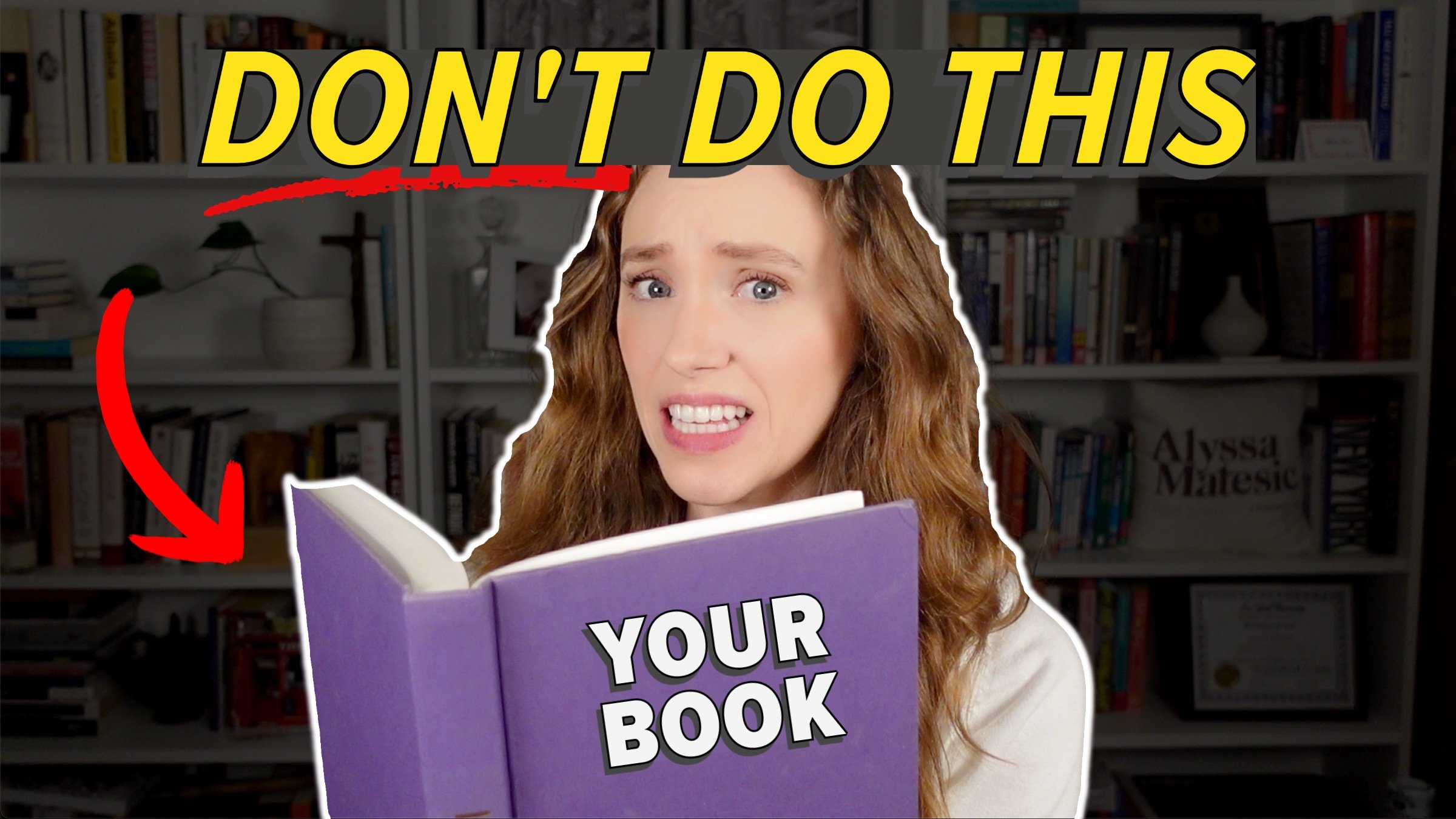Have Some Perspective! Common Mistakes When Writing Close Third Person
HIT PLAY OR READ THE POST BELOW:
When writing fiction, point of view is everything. It determines how the reader is going to experience the story, as well as which characters they get the most invested in. As a structural book editor, I am constantly evaluating and analyzing point of view in every story I work with. In some cases, I even recommend changing the point of view. It’s a storytelling element that writers should be aware and conscious of from the very beginning of their process.
In this article, I'm going to talk about the close third person perspective and give you some strategies to ensure you are utilizing this perspective correctly. Writing close third person perspective is different from omniscient third person perspective in that it only follows the point of view of one specific character at a time. Either your entire novel is written in close third person perspective, following the protagonist, or your novel follows different characters in close third person perspective, delineated by section or chapter breaks.
I enjoy close third point of view and read a lot of novels written in it because it allows the reader to get intimate insight into a character's perspective without necessarily imposing the character’s voice onto the reader. However, it is easier to slip out of third person point of view compared to first person perspective.
To help you use this perspective most effectively, I will reveal the top five most common writing mistakes I see writers make when they are writing in close third person and also walk through some examples.
1. Showing Other Characters’ Thoughts
The first and biggest mistake when it comes to writing in close third person is showing other characters’ internal thoughts. When choosing to write in close third person, you are committing to telling the story through the lens of a single character's mind, the Point of View (POV) character.
Whether you are following the single character for a chapter or two, or for the entirety of the novel, you cannot have any lines peeking into the minds of other characters. Everything has to be contained to that POV character.
This may sound pretty obvious, and you might be wondering why I am bringing it up. But this is a mistake I actually see in nearly every close third person novel I edit. This mistake can sneak up on you, especially since, as the writer, you might not realize you are showing something the POV character wouldn't know.
Fixing this mistake is pretty straightforward. If you notice that you’re slipping into other characters’ perspectives, you can just remove those lines. Alternatively, you can revise and tweak the statement so that we do get the same information, but from the POV character's perspective.
Here is an example:
Megan watched the fireworks go off above the Ferris wheel. She remembered the time her first boyfriend took her to the fair and kissed her at the top of the ride.
She shook off the memory when Casey nudged her. Casey could tell something was bothering Megan. The two walked toward the parking lot.
Can you see the moment where we depart from Megan's point of view? It may not be obvious at first glance. However, Megan realistically would not have access to the information in paragraph two, sentence two: that Casey can sense her worries. In that moment, the reader is being shown Casey’s mindset.
Here’s a revision:
Megan hoped Casey couldn’t tell something was bothering her. The two walked toward the parking lot.
Here, the sentiment is admittedly a bit different. Rather than seeing Casey actively picking up on Megan’s emotion, we see Megan wondering whether or not her emotions are being broadcasted. However, this difference allows the reader to stay within Megan’s head.
I recommend going back through your manuscript and seeing if you can identify any places where you are unintentionally departing from your POV character, then revising accordingly.
2. Naming Unknown Characters
The next mistake I see in close third person stories is when authors name-drop characters the POV character doesn't know yet. This occurs when you, obviously, know the name of a newly introduced character, but in the story, the POV character doesn’t yet. However, they still somehow are mentioning that new character by name.
This is another small detail that doesn’t seem too obvious, but when it occurs, it brings the reader out of the story. Just like how in real life, you wouldn’t know a person’s name ahead of time, readers will expect your POV characters’ knowledge to likewise stay consistent. By keeping the character introductions clear, this ensures that the reader stays within the POV character’s perspective.
If you notice this issue occurring, what you can do is describe the unknown character using perhaps a visual indicator to denote who they are until the POV character learns their name. Then, of course, you can switch to calling them by their name.
Here’s an example:
In the parking lot, Megan noticed a stranger lingering next to her car. Her heartbeat quickened and she gripped her key in her pocket. Tim tried to open the passenger door.
So the obvious problem here is Tim. The narration mentions that there is a stranger next to her car, so Megan shouldn’t know his name. Instead of dropping his name, you could instead describe him in general terms as in the introduction.
Here is the revised version.
In the parking lot, Megan noticed a stranger lingering next to her car. Her heartbeat quickened and she gripped her key in her pocket. The man tried to open the passenger door.
This simple fix streamlines the scene and ensures that the reader doesn't get confused with why you are naming a character that the POV character does not know.
3. Writing Internal Thoughts in Third Person
The next mistake is writing the POV character’s internal thoughts in third person. By virtue of writing in close third person, the majority of your manuscript’s text should be in third person. The one exception is when you write a line of dialogue, verbal or inner, that comes from the POV character’s perspective.
When you are trying to convey an internal thought the POV character is having, the text should be in italics and written in first person. It should sound like how that character speaks to themselves in their head, which is in first person and not in third person. The line should also be italicized and not within quotation marks, as that may cause confusion between what is being said inside their head and what is being said aloud.
Let me show you an example:
Megan held Casey's shoulder and stopped walking. “What is that man doing? Is he trying to threaten them?”
The sentiment of these lines is clear: Megan is wondering what the man is doing and if he is threatening her and Casey. However, the second question she asks herself needs to be tweaked to be in first person. Luckily, this is a quick fix.
Megan held Casey's shoulder and stopped walking. What is that man doing? Is he trying to threaten us?
Here, “them” has been changed to “us” so that the internal thoughts are in first person instead of third person. Plus, the thoughts have been italicized to confirm that they are from Megan’s mind.
4. Forgetting Reactions
The next mistake I see in close third person stories is forgetting the POV character’s reactions to events. Just like in first person stories, the reader wants to experience the story in the way the POV character experiences it when reading close third person novels. That includes feeling and seeing the things they feel and see.
This all includes their responses or reactions to any pivotal plot developments. If something significant happens or someone says something shocking and we don't see the POV character's reaction, it is going to feel like something is missing. The reader will wonder how they reacted.
The way to fix this is to place yourself in the character's shoes. If you are reacting to some development in the plot, make sure they are as well. Writing those reactions into the narration is going to amplify the emotional stakes of each scene. The reader will see exactly what’s at stake for your point of view character.
Here is an example:
Using some kind of tool, the man wedged open the passenger door and began to rummage around Megan's car. Casey took out her phone and dialed 911.
This example goes from event to event. There is a man breaking into Megan’s car and Casey calls 911. There’s nothing grammatically incorrect and there's nothing incorrect from a story perspective. However, it is missing a response and reaction from Megan. The reader expects to see her response to her car breaking in, as it’s a shocking event to witness. So make sure you are incorporating that response.
Here’s the revised version:
Using some kind of tool, the man wedged open the passenger door and began to rummage around Megan's car. Megan tried to stifle tears, realizing he would probably find and take the anniversary gift Casey had given her at dinner. Casey took out her phone and dialed 911.
Do you see how this amplifies the emotional stakes of the scene? Now, the reader sees that there is something valuable in that car that Megan is concerned about. This amplifies the drama of the scene, making it feel more realistic and intriguing to the reader.
5. Narrator Interjections
The last mistake I see when writing close third person narration is letting the narrator interject. Close third person can be a tricky perspective to write in, perhaps the trickiest, because you are balancing having a narrator who is writing in third person along with a POV character who feels like the center of the story. Everything the reader sees is through them.
You need to balance the role of the narrator with the role of the POV character. To do this, you want to make sure the narrator doesn't inadvertently drop any subjective commentary on the scene. This often comes in the form of an adjective or an adverb that is in the third person narration that might not necessarily match up with what the POV character is feeling.
You want to ensure you are containing all emotionally charged words in the scene to what the POV character is experiencing themselves. You don't want the narrator to add a layer of commentary and subjectivity onto the scene, because it will be confusing and muddle the narrative.
Here is an example, which will hopefully make this issue clearer:
Just then, the man turned toward Megan and Casey. Shockingly, he shut the car door and ran off into the field beyond the parking lot.
Can you identify where there is some commentary from the narrator? In this excerpt, it's just one word: “shockingly.” However, who is saying that this is “shocking?” It seems to be coming out of thin air from the narrator. This sentiment can still be portrayed through Megan's perspective, with just a few tweaks.
Here’s a revised version of the excerpt:
Just then, the man turned toward Megan and Casey. He shut the car door and ran off into the field beyond the parking lot. Megan was equal parts shocked and relieved.
Here, the reader can see how Megan is experiencing and feeling the events herself. She's not only shocked, in this case, but also relieved. This again ties us back to Megan and her experience, which, as our POV character, is the way you should be telling the story.
I hope these tips help you catch some writing mistakes and fix them to make an even stronger close third person narrative.
Thanks so much for reading and happy writing!





